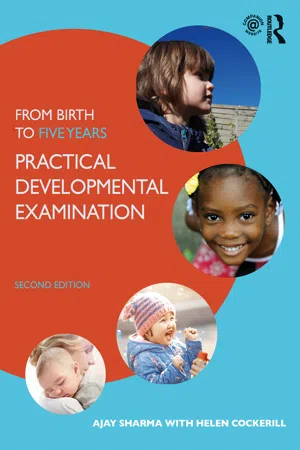
- 140 pages
- English
- ePUB (mobile friendly)
- Available on iOS & Android
About this book
This fully updated new edition of From Birth to Five Years: Practical Developmental Examination is a step-by-step 'how to' guide to the developmental examination of pre-school children. Based on up-to-date research into current child development philosophies and practices, this text supports the wider group of professionals who are required to assess children's developmental progress as part of their day-to-day working practices.
It begins with a practical framework for developmental examination, then progresses through each of the key developmental domains, offering guidance on enquiry and observation, and on how to chart typical and atypical patterns, with red flags for recognising significant delay or disordered development. Advice is also given on how to make sense of the findings and how best to communicate this information to parents. To consolidate and expand on the practical and theoretical information across this book and its companion, Mary Sheridan's From Birth to Five Years, an updated companion website is available at www.routledge.com/cw/sharma, which includes the following additional learning material:
- An interactive timeline of the key developmental domains;
- Introductions to theory with links to further reading;
- Research summaries;
- Video clips demonstrating practical assessment skills;
- Downloadable resources including pictures to support examination of verbal and non-verbal development, and tips to facilitate and promote development.
Developed alongside the original Mary Sheridan's From Birth to Five Years: Children's Developmental Progress, this unique guide expands on its normative developmental stages by offering practical guidance for health, education and social care professionals, or anyone concerned with monitoring children's developmental progress.
Frequently asked questions
- Essential is ideal for learners and professionals who enjoy exploring a wide range of subjects. Access the Essential Library with 800,000+ trusted titles and best-sellers across business, personal growth, and the humanities. Includes unlimited reading time and Standard Read Aloud voice.
- Complete: Perfect for advanced learners and researchers needing full, unrestricted access. Unlock 1.4M+ books across hundreds of subjects, including academic and specialized titles. The Complete Plan also includes advanced features like Premium Read Aloud and Research Assistant.
Please note we cannot support devices running on iOS 13 and Android 7 or earlier. Learn more about using the app.
Information
1 A practical framework for developmental examination

The purpose
Methods and tools
- A. Standardised development tests: These tests, for example, Griffith’s or Bayley’s scales, compare children’s performance to the expected norms for their level of abilities or function. They are considered the gold standard by some but may be impractical in terms of time, unsuitable for the child’s comprehension or motor abilities, and often too narrowly focused on measuring development (Greenspan and Meisels 1996).
- B. Eclectic structured methods: These methods combine the knowledge of child development with a system of eliciting information about the child through enquiry, making structured observations using appropriate tools and making sense of the findings in the context of the risk and protective factors for the child. One such method is described in this book. It may, on its own, lack the sensitivity and specificity of standardised assessments but combined with the right knowledge, training and experience, it has a useful place in clinical practice. It enhances practitioners’ awareness about how development progresses and helps them identify the child’s strengths and vulnerabilities, and provide the necessary guidance and support.
The framework

Asking
Listening and eliciting concerns
|
| Source: Glascoe (1999) |
BOX 1.1 Barriers to parents raising concerns or accessi...
Table of contents
- Cover
- Half-Title
- Title
- Copyright
- Contents
- A visual tour of the book
- Companion website
- Introduction
- 1 A practical framework for developmental examination
- 2 Clinical evaluation of motor development
- 3 Clinical evaluation of fine motor development
- 4 Clinical evaluation of cognitive development
- 5 Clinical evaluation of speech, language and communication development
- 6 Clinical evaluation of social behaviour and play development
- 7 Clinical evaluation of attention development
- 8 Clinical evaluation of emotional development
- 9 Self-care and independence
- 10 Vision and hearing
- 11 Physical examination and investigations
- 12 Making sense of findings
- 13 Protecting vulnerable children
- 14 After the assessment – next steps
- 15 Enabling parents, promoting development
- Internet resources
- Pictures to support examination of verbal and non-verbal skills
- Glossary
- References
- Index